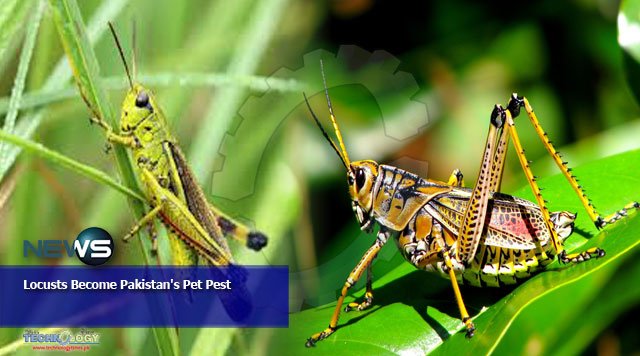Pet, It is the third generation of locusts sighted flying from one district to another ever since they first entered the agriculture rich Sindh province via Balochistan in May 2019.

But provincial agriculture officials have predicted the emergence of its fourth generation after upcoming monsoon rains.
In fact, there has been no significant loss by locusts. They have been reported in almost all the 29 districts of the province, including coastal areas, where they have just entered in July. They do not stay at any place for longer and seem flying in the directions of wind, agriculture officials say.
Only a small population landed on crops and vegetation, causing damages in parts of Sindh province, reports gathered by The News said and added that otherwise, they were in flying phase, causing fear and panic among farmers.
Qamaruddin Solangi of Sindh Agriculture Extension Department, involved in locusts control mechanism in Khairpur district, said, “We are looking at its gateway, while entering Sindh from Balochistan province of Pakistan”.
“After expected monsoon rains we will see their fourth generation in Sindh, since their arrival last year,” Solangi said.
Some officials believe the locust always flies in the winds direction and most probably they move to desert areas, Tharparkar, Sanghar, Umerkot, Khairpur, and Sukkur, which may be suitable to becoming their ultimate breeding grounds.
Muhammad Siddiq of Rural Development Association (RDA) in Tharparkar said, “After recent rains the desert areas are receiving swarms of locusts from different directions. Though, at present there is no report of loss from any side, previously they had damaged natural fruit trees and important shrubs, which livestock consume fondly”.
“Thus, it is feared that Pakistan may be a new breeding ground of locusts, mainly desert parts always attract this insect species for inhabit there for some time.”
“The recent rains have covered almost all the desert areas, including parts of Umerkot district where farmers are preparing to cultivate traditional crops. Similarly, herders, who earlier migrated to canal areas are returning back as usual to see blooming green pastures for their herds,” Siddiq said.
Siddiq said farmers of Thar were frightened that locusts would remerge after this monsoon season and may destroy newly germinating crops, grasses, and trees.
“Presently, locusts are in flying phase everywhere and only a small number is reportedly landing on trees, shrubs and crops, but no significant loss has been reported,” he said.
Ali Akbar, a small-scale farmer near Bhitshah, Matiari district, said he had lost newly cultivated onion, standing on three acres of land.
Similar reports gathered from Sanghar, Badin and Sujawal show the presence of locusts in all canal areas, posing threat to agriculture economy. They are flying over and at the nighttime some of population comes down and damages the crops near them.
Reports reaching here show that farmers in different areas have overused pesticides whenever they witnessed landing swarms of locusts at their crops, which may have longer effects on soil and biodiversity.
Prof Ismail Kumbhar of Sindh Agriculture University (SAU Tandojam said, “The UN Food and Agriculture Organisation’s (FAO) has warned that Pakistan is among countries like Sudan, Ethiopia, South Sudan, Somalia, and India that will remain on high alert during the next four to five weeks.
In Pakistan, 60 percent of Balochistan, 25 percent of Sindh, and 15 percent of Punjab are said to be the breeding grounds for the desert locust. “Humid and moist conditions and monsoon in Sindh is right around the corner,” Prof Kumbhar said.
He highlighted the importance of agriculture sector that was the engine of Pakistan’s economy and fed more than 200 million population, adding, around 67 percent population depended on agriculture for livelihood.
He said since the last two years locust population was increasing exponentially because of huge breeding. “The fear among farmers is justifiable that these grasshoppers have reportedly caused food insecurity in their original countries where from they moved to other parts of the world, including Pakistan.”
Farmers might lose agriculture crops and entire vegetation cover, which could lead to food insecurity, he added.
Kumbhar said the federal and provincial governments failed to control the locust Pet swarms at regional and national levels and the poor and small farmers were facing issues at grassroots level. However, he said due to the COVID-19 pandemic farmers were already facing issues to export their agriculture products to the international market.
The professor said the federal government claimed that only five districts of Sindh had been affected by the locust Pet, but in reality, they were reported to be present in all the districts of the province.
He said that locust emerged in Pakistan in May 2019 and still the government had not been able to successfully control it, despite all tall claims. The agronomy scholar advised the government to conduct a fresh survey to assess the crop damages caused by locusts Pet, adding while the farmers be given compensation.
Apart from this, he suggested that a national emergency plan be framed on war footing to check its spread in Pakistan.
According to reports Sindh province, mainly desert parts may become the breeding grounds of desert locusts, which may play havoc with crops and vegetation in future.
Leading growers believe that the month of August may be severe in terms of attacks by fourth generation of locusts in Pakistan. They accused the provincial government of not taking responsibility to use resources to save agriculture economy.
Sindh has got airplanes for aerial spray to control locusts Pet at its breeding grounds, but the authorities were still reluctant to use the resources with proper planning.
The agriculture officials have a different stance over the aerial spray to kill locusts, believing it can also cause damage to humans and animals during this action.
They are planning to take action during its breeding in Thar desert. But coronavirus as
well as financial capability are also key issues confronting the government in its war on locusts.
This news was originally published at thenews.com.pk